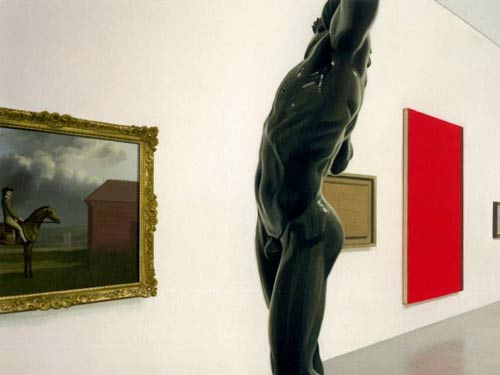Edinburgh Art Festival 2008, Various galleries, Edinburgh
Andrew Grassie's clever conceptual tricks are a highlight of the Edinburgh Festival

Your support helps us to tell the story
From reproductive rights to climate change to Big Tech, The Independent is on the ground when the story is developing. Whether it's investigating the financials of Elon Musk's pro-Trump PAC or producing our latest documentary, 'The A Word', which shines a light on the American women fighting for reproductive rights, we know how important it is to parse out the facts from the messaging.
At such a critical moment in US history, we need reporters on the ground. Your donation allows us to keep sending journalists to speak to both sides of the story.
The Independent is trusted by Americans across the entire political spectrum. And unlike many other quality news outlets, we choose not to lock Americans out of our reporting and analysis with paywalls. We believe quality journalism should be available to everyone, paid for by those who can afford it.
Your support makes all the difference.I'd guess the people who plan the Edinburgh Art Festival have to guard against perceived Scottishness – of being seen to buy into the whole skirl o' th' pipes thing peddled along the Royal Mile. This would explain the typical absence of Scottish artists from their programming, although, as with last year's festival, the best show in town is by a local boy. In 2007, it was the Dundonian David Batchelor's Unplugged; for the 2008 Art Festival, it is the Edinburgh-born Andrew Grassie's Painting as Document. Both are at Talbot Rice. If the gallery's clever programming suggests a little light nationalism, then Scots wha' hae'.
Grassie makes snapshot-sized photorealist paintings of other artists' works, often hung in his studio. So fine is his squirrel-hair brush, so meticulous his touch, that it takes close study to see that pictures such as Tate New Hang are paintings. Installation – Gillian Wearing is apparently a photograph of that artist's Signs photographs, stacked against the wall of a gallery – perhaps Maureen Paley, Wearing's dealer. Probably, little of this is true: the photo is actually a painting and the studio is Grassie's. So many games are being played here that your head spins. Conceptual painting – into which newly minted category this work falls – can be dry as dust. Grassie's has a sense of real event, of genuine (if odd) painterliness. If you see one show in Edinburgh, make it this.
Grassie apart, the 2008 Festival is woefully Sassenach: Emin; Richards Hamilton and Wilson at Inverleith House and the Grey Gallery, respectively; Mark Wallinger at the Ingleby. The last is also showing work by Susan Collis, although the new Ingleby is on one of those Edinburgh streets accessible only by helicopter. I got close enough to see Wallinger's billboard project – a black-on-white affair that says "MARK WALLINGER IS INNOCENT" – but managed never to arrive. Whether any artist can really claim innocence is a moot point, but Wallinger is as likely a candidate as any.
His work also ties in with Richard Hamilton's at the Royal Botanic Garden. Wallinger's State Britain marked him out as a political artist, and Hamilton is the grandaddy of British agitprop. Inverleith House is showing nearly half-a-century of his Protest Paintings, taking us from Kent State to Shock and Awe by way of the H-blocks, Mrs Thatcher and, inexplicably, Hugh Gaitskell. (Gaitskell provoked Hamilton's wrath by voting against unilateral nuclear disarmament. The artist was still painting him as the Phantom of the Opera 20 years later.) There's something Rowlandsonian about this one-man battle to reclaim political imagery from the media, although Hamilton's work is too shouty to be great satire.
By contrast, Richard Wilson's has a lunacy that beats the mad, mad world at its own game. The Grey Gallery's show is mostly of films – Wilson hacking his way with drills and saws from a moving taxi in The Meter's Running; spinning a disc cut from the façade of a Liverpool office block in Turning the Place Over; building a jalopy aeroplane in Butterfly. None of these is overtly political, and yet the collective story they tell is of capitalist decay. Hot Dog Roll is a fast-food van apparently designed by Zaha Hadid. Does that seem impossible?
A different but similar story is told at Doggerfisher by the young German artist Alexander Heim. Heim is a poet of the thrown-away. In a small film a pigeon picks its way among the tables of a café; sculptures of scuffed papier mâché turn floors into walls; pots are dotted around, their glazes collecting in pools. Heim's touch is light but firmly his own, the insistent handmadeness of his work rejecting the hands-off aesthetic of the YBAs. His work is too gentle for easy categorisation, though environmental Arte Povera springs to mind. It is very good.
And so to Janet Cardiff and George Bures Miller at the Fruitmarket. The Canadian duo do sulphurous installations that make the visitor complicit. In The Dark Pool our presence triggers whispers from gramophone horns: "Listen ... is there someone there?" "Why do you want to know?" Pressing a button on The Killing Machine sets in motion an American-style execution chamber: think Stanley Milgram meets Ridley Scott. There are shootings in a cinema, Unabomber cabins. This is low-high drama. It's not my kind of thing, but it's extraordinarily well done; and the Fruitmarket is right next door to the Edinburgh Dungeon, so you can compare and contrast.
Edinburgh Art Festival to 31 Aug (edinburghartfestival.com)
Join our commenting forum
Join thought-provoking conversations, follow other Independent readers and see their replies
Comments